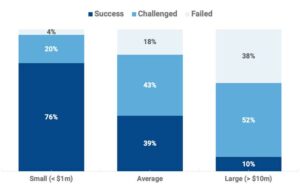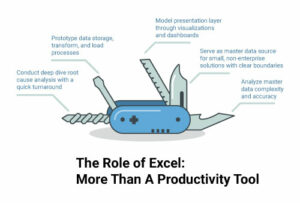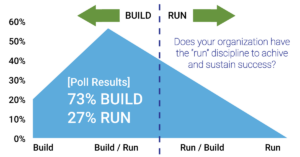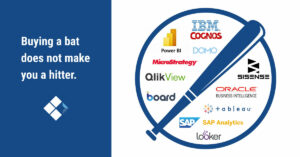According to a recent McKinsey survey, two-thirds of B2B customers prefer remote human assistance or digital self-service when making a purchase. If you’re working to align your strategy and technology to serve these savvy buyers, understanding your level of digital readiness is key. After all, you’ll likely get only one chance to succeed.
Digital Readiness – Internal and External Expectations
When preparing to deploy digital capabilities to your customers or channel partners, you will need to consider both internal and external expectations.
Within your organization, will the digital transformation drive the value you expect? Or will you struggle to drive acceptance and adoption?
Regarding external stakeholders, are you set to wow them and make it easier to do business with you? Or will you send them running to your competitors?
Understanding the true state of your digital readiness in a few key areas will go a long way toward ensuring digital transformation success. In this article, we’ll explore the top pillars to consider, including:
Pillar #1: Digital Solution Design
First and foremost, your digital solution design must be comprehensive enough to meet the business requirements you set out to achieve.
Are all of the requirements built-in? (HINT: Your IT department may think very differently about them than you do.)
If IT lacks understanding of certain elements, does not want to build them, or thinks they could be implemented in a future phase, they may ignore critical requirements.
Pillar #2: Digital Solution Testing
We know—no one enjoys testing!
Testing is really a mindset. You need to be comfortable poking holes in work done by friends and colleagues.
As uncomfortable as it might be, preparing an effective testing plan before going to market is essential. It uncovers issues as simple as a misspelled word or as complex as completely missing the mark on a critical requirement.
Your testing plan should include a comprehensive sequence of testing layers and lay out your execution plan. Your goal here is to truly flush out any defects, gaps, or issues well before you go live.
As business change consultants, we see situations regularly where the proper testing rigor was not in place. A few dozen problems unaddressed before go-to-market can mushroom into hundreds of issues postlaunch.
Think of your digital solution testing plan as preventive vs. emergency care. Finding defects is good! Flushing them out ahead of time is much better than having your customers find them later.
Pillar #3: Data
Real Scenario:
An e-commerce company developed the entire process for its digital offering based on ten products and just five customers. In reality, they have tens of thousands of products and hundreds of customers! The sample set was simply too small to address every real-life case effectively.
It’s impossible to cover all scenarios without a complete view of your data. Here are the questions you’ll need to ask:
- Do we have all the go-live data?
- How do we put data into production?
- How do we execute a data conversion?
Data Conversion: The #1 Gap in Digital Transformation Solutions
Failure to plan for data conversion is the number one gap we’ve identified over twenty years helping large companies succeed with digital transformation.
Data conversion may be treated as an entirely separate project. In this case, the company has failed to consider how they’ll put data into the new production environment, along with how long it might take, how they’ll perform cutover testing, and how they’ll turn off data in legacy environments.
Do you have all your data? Your go-live data needs to include your users, customers, product catalog, pricing, and complete product attributes.
Pillar #4: Infrastructure
When working on internal systems and infrastructure, you are in complete control of every aspect of your project. However, when it comes to digital transformation, you must also consider every possible external user environment.
Your external testing should include:
- Open ports, VPNs, SSL
- Every possible device
- Different browsers
- Forms
- External and internal emails
- Documents
- Payment interfaces
Does everything work in every environment?
Pillar #5: Content
The process to include and manage content is typically another large gap in digital transformation projects. This includes your brand, marketing message, and users’ experience.
Every interaction between your users and your digital system is an opportunity to enhance your marketing message and branding.
Marketing Messaging
How are you creating demand?
Your users want digital self-service. Is influencing those targeted eyeballs with relevant content part of your plan? What will you include to help them solve their current problem? The right strategy here helps solidify your competitive position.
Branding
How are you perceived?
Your digital solution—from marketing messaging to colors, buttons, images, and more—needs to be consistent with everything else your customers see.
The best possible scenario involves a parallel path. IT builds the features and functions of the app, and marketing handles the overall look and user experience. In addition, you must have a plan to build, store, and maintain this content throughout development and a way to support it post-launch.
Balancing Acts
Do your teams know the roles they’ll play?
Preparing to balance resources during development and after go-to-market is another crucial element of any successful digital transformation. You’ll need decision-makers to allocate tasks among groups, like:
- Project developers vs. content developers. Where will the content live and when should you get content developers involved?
- Project workloads vs. current regular workloads. Who has ownership and authority to move your project forward?
- Those who deliver the capability vs. those who’ll own it when complete. Communication between these groups is critical.
Pillar #6: Commercialization
Technology says they’re done. Now what? How do you get to commercialization and adoption?
Most organizations don’t address this question. They’re exhausted when they think the project is complete. They lose focus of their overarching business objectives and just want to move on.
Incorporating the answer to this question into your digital solution design from the start will help ensure successful adoption. Organizations should ask:
Who is going to own digital adoption post launch?
Assign your ADOPTION CHAMPION. This person—or team—will ensure:
- Your internal operations reflect the necessary change
- The right message is communicated externally
- The technology produces the benefits set out in your solution design
What’s in it for your users?
Why will users care about your digital application? They’re not concerned about benefits to the company; they just need to know how it affects them.
You need to hone in on the value to the user and the consequences if they don’t adopt. This gets lost a lot.
What behaviors do we want to change and how will we measure ongoing use and success?
Let’s say, for example, that phone calls are down and online quotes are up. How do you know where the shift happened and why? How can you repeat, enhance, or correct trends?
What is IT’s level of responsibility post launch and to ensure commercialization?
After thirty days of “hyper care,” IT is typically done. But this is when the actual work starts. Will IT be responsible for ongoing care and management?
Does your C-suite understand that changing external behavior is an ongoing process?
For real change to take place, an effective plan is a 60-, 90-, 120-day and beyond exercise of ongoing engagement. Carefully set expectations with all stakeholders.
Pillar #7: User Support
How will internal users (including testers) and external users get help?
User support must be considered during project development and postlaunch.
A soft rollout can help train and prepare your internal staff to provide the best support.
This is also a great opportunity to rally your support team to truly own the customer relationship. Many companies make the mistake of treating this group as lowly employees, when in fact, they are more knowledgeable about your customers than anyone else in your organization. Many customers have more contact with support staff than any other teams in your company–make sure these experiences are positive!
As part of your soft rollout, it’s a good idea to treat and train your support team well. If they’re unclear, they will convey their frustrations and misunderstandings to your customers. If they’re confident, your customers will feel confident as well.
Ensure Your Digital Readiness
With some thoughtful preparation and planning, you’ll have a solid foundation moving forward. Understanding the true state of your digital readiness in these key areas will go a long way to ensure your digital transformation success.
If you have questions or need assistance ensuring you have the right plan in place for your digital transformation process, the Clear iQ team is ready to help. We work with $500M+ companies to find and implement actionable solutions to their most important challenges. Contact us today to get started.
Meta Desc: Learn how to evaluate your digital readiness and the most important steps to take to ensure your digital transformation success.
#digitaltransformation #b2b #manufacturing












